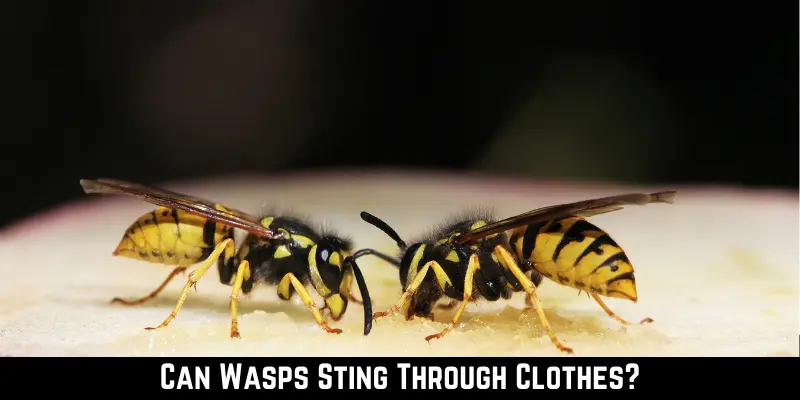Wasps are common summer pests. As they are common in summer, you are susceptible to getting their sting. And when they are buzzing around, it’s natural to fear them. Although they mainly bite on exposed body parts, you must wonder, Can wasps sting through clothes?
Yes, wasps can sting through clothing, but the fabric you wear matters. Thicker fabrics like denim or leather can better protect against wasp stings than thinner materials like cotton or lightweight synthetic fabrics. However, if wasps decide to sting, they may still do it through clothing.
Do you want to know more about wasps sting and their effects? If so, buck up till the end of the below guidelines.
Do All Wasps Sting You?
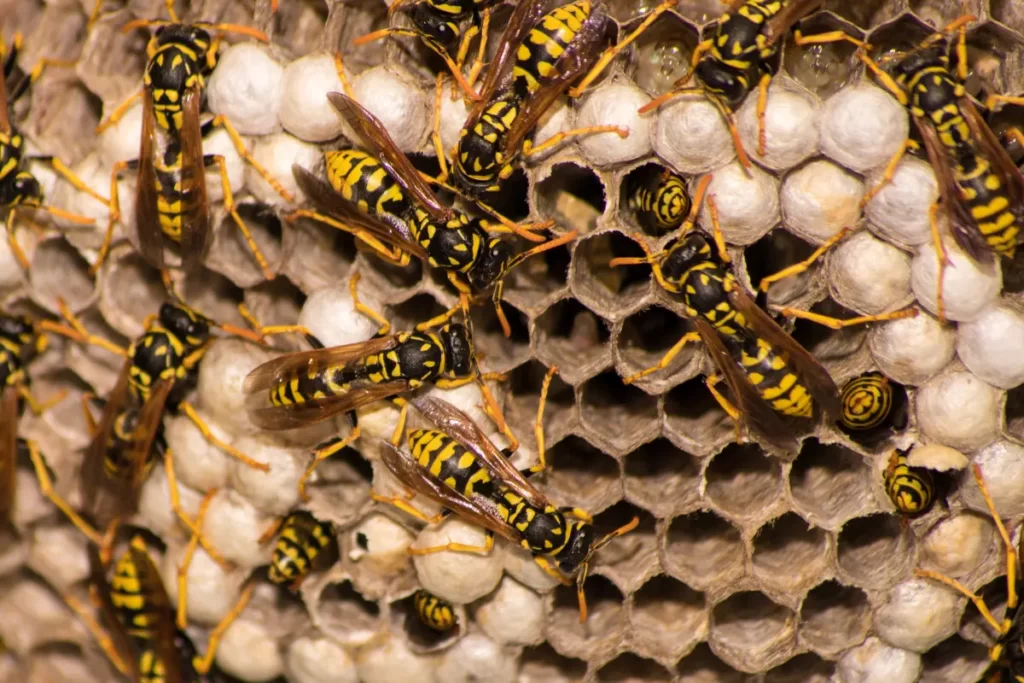
Although all wasps have stingers, not all wasps sting you. However, it’s important to note that all female wasps are capable of stinging, as their stingers are modified egg-laying organs.
Some wasp species are more prone to sting if they feel threatened or if their nest is disturbed. For example, paper wasps, yellowjackets, and hornets are more likely to sting when they perceive a threat. Social wasps, which live in colonies, tend to be more defensive of their nests and can be aggressive if they feel their nest is being threatened.
On the other hand, solitary wasps are generally less likely to sting because they don’t have a colony to defend. They are more focused on hunting for prey and reproducing. Above all, if you find yourself in a situation where wasps are aggressive or you’re at risk of getting their sting, it’s advisable to slowly and calmly move away from the area.
Why Wasps Sting?
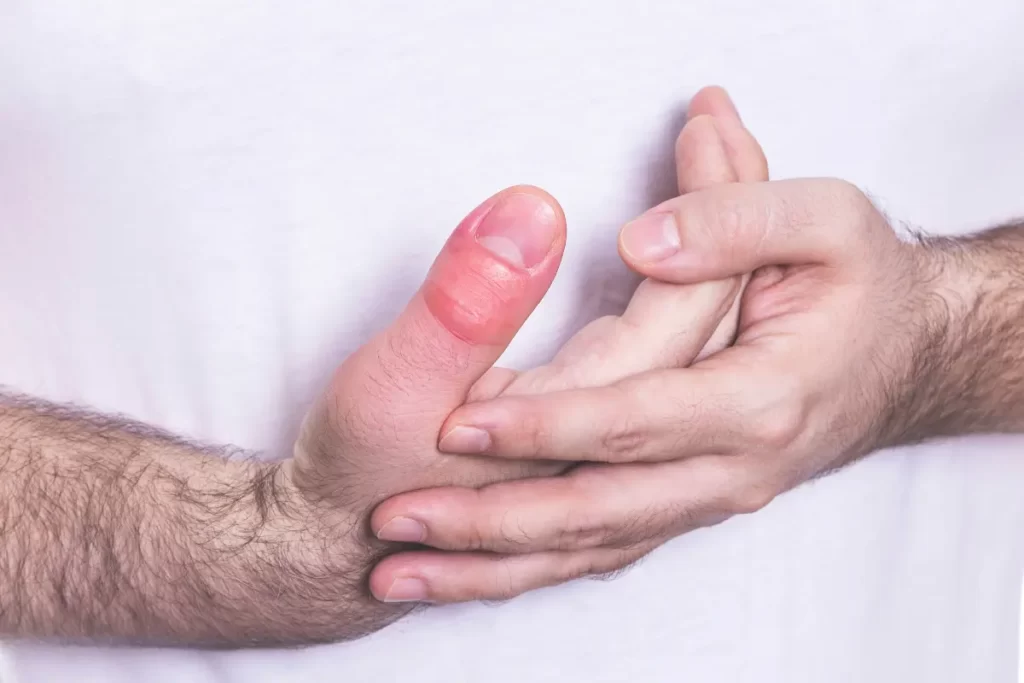
Wasps sting primarily as a defense mechanism. They use their stingers to poison their enemy when they feel threatened or think their nest is being attacked. This venom can cause pain, inflammation, and allergic reactions to you. Below are some reasons why wasps may sting:
- When a wasp perceives a potential danger, it will respond by stinging. It can happen if you come too close to a wasp nest or if they feel cornered.
- They may also sting to protect their nest and the other members of their colony from perceived threats.
- Some wasp species have strong territorial instincts and may sting you or other insects if intrude on their domain.
- Moreover, if they feel that their food source is at risk, they may sting you to defend it.
- Lastly, wasps may sting predators to deter them from attempting to eat them.
How Does a Wasp Sting?
A wasp stings by its ovipositor, which is a specialized egg-laying organ for defense. According to the journal PNAS, the ovipositor consists of three sliding valves that are joined longitudinally. In female wasps, the ovipositor has evolved into a stinger.
When a wasp decides to sting, it raises its abdomen and extends its stinger. It is the moment right before the sting occurs. The wasp then thrusts its stinger into the target. As the stinger penetrates the skin, venom is pumped from the venom sac through a small canal in the stinger and into the target.
After the sting, the wasp typically retracts its stinger. Additionally, in some social wasp species, like yellowjackets, when a wasp stings, it releases alarm pheromones. These chemicals can signal other nearby wasps to become more aggressive and can result in a group attack.
Composition of Wasps Stingers
A wasp’s stinger is a unique organ that they use for defense. According to the journal Scientific Reports, the wasp stinger has three longitudinal parts, basal, apical, and medial. The major components of their stingers include stylet, lancet, and tip.
The main part of the stinger is a sharp, needle-like structure called the stylet. It is the part that penetrates the skin of the victim. Connected to the Stylet is a venom sac. This sac contains venom that the wasp injects into its target.
Furthermore, some species of wasps have barbs or hooks on their stingers. These can make it more difficult to remove the stinger once it’s embedded in the skin. Additionally, the stinger also contains nerves and sensory organs that allow the wasp to perceive the environment and respond to stimuli.
Can a Wasp Sting You Multiple Times?
Yes, a single wasp can sting you multiple times. Unlike honeybees, which have barbed stingers that get stuck in the skin and cause the bee to die after stinging, wasps have smooth stingers that allow them to sting multiple times without getting stuck.
It means if you encounter an aggressive or threatened wasp, it can sting you repeatedly if it feels the need to defend itself or its nest. Each sting can be painful and may cause localized swelling, redness, and discomfort. Therefore, it’s crucial to get medical help if a wasp stings you several times or if you have an adverse reaction to a wasp sting.
What Kinds of Clothing Are Susceptible to Wasp Stings?

Wasps lure to vivid hues, flowery patterns, and certain textiles. The following apparel may increase your risk of receiving wasp stings:
- Loose-Fitting Clothes: Loose-fitting clothing can trap wasps, making it more likely for them to sting you if they feel threatened.
- Flowy Fabrics: Fabrics like silk or chiffon, which flow and move in the wind, can attract wasps. As they like it, they may mistake it for a flower or something else.
- Perfumed or Scented Fabrics: Fragrances can attract wasps, so if your clothing has a strong scent, it might increase the likelihood of a wasp approaching you.
- Stained or Dirty Clothes: Food or drink stains on your clothes can also attract wasps, as they are drawn to sugary substances.
- Natural Fabrics: Wasps are known to be attracted to natural fabrics like cotton and linen.
- Bright Jewelry: Shiny or reflective jewelry can also attract wasps, as they might mistake it for something they want to investigate.
How Does a Wasp Sting Through Clothes?
A wasp can sting through clothing because its stinger can pierce various materials, including fabric. The stinger is a sharp, pointed structure that can easily puncture skin, and it’s capable of penetrating clothing as well. It works by thrusting into the target, injecting venom as it goes. The venom is what causes the pain and irritation associated with a wasp sting.
Even though clothing can provide some level of protection and may slow down the wasp’s stinger, it often isn’t enough to prevent a sting entirely. Thicker fabrics and multiple layers of clothing can offer better protection compared to thin or tight-fitting materials.
However, it’s worth noting that some wasps have particularly strong and sharp stingers, and they may be more likely to penetrate clothing.
Which Clothing Should Be Avoided Around Wasps?
Wearing clothes that act as a barrier and lower the risk of a wasp’s sting is a good suggestion when it comes to avoiding wasp stings. Here are some tips on what to wear to minimize this risk:
- Avoid Floral Patterns: Wasps are naturally drawn to floral patterns, as they associate them with flowers.
- Avoid Loose-Fitting Clothing: Loose clothing can make it easier for a wasp to get inside and sting you. Opt for well-fitting clothes instead.
- Avoid Scented Products: Wasps are also attracted to scents, including those in perfumes, lotions, and hair products. It’s best to go for unscented options if you’re going to be in an area where wasps are present.
Remember, while these tips can help reduce the likelihood of a wasp’s sting, it’s also important to remain calm and avoid making sudden movements if a wasp is nearby.
Which Clothing Colors Should Be Avoided Around Wasps?

Wasps draw to vivid, bright hues, especially white and yellow. If you want to avoid attracting wasps, it’s best to steer clear of clothing in these colors:
- Yellow: This color is highly attractive to wasps as it resembles the flowers they feed on.
- White: Wasps are also drawn to white, possibly because it resembles certain types of flowers or because it reflects light in a way that catches their attention.
- Floral colors: Clothing with floral patterns can sometimes attract wasps because they might mistake the pattern for real flowers.
- Bright Reds and Oranges: While not as attractive as yellow or white, bright reds and oranges can still catch a wasp’s attention.
Instead of these colors, consider wearing muted or neutral tones like brown, green, or blue when you’re in an area where wasps are prevalent. These colors are less likely to draw their attention. Additionally, avoid wearing heavily scented perfumes or lotions, as these can attract wasps.
When Around Wasps, Should Perfumes be Avoided?

Yes, you should avoid wearing strong perfumes or scented lotions when there are wasps around you. Wasps draw to strong scents, including floral fragrances. Wasps allure to strong scents, including floral fragrances. Wearing perfume can potentially attract them and increase the likelihood of a close encounter, which may lead to stings.
Moreover, you should especially avoid perfumes that are scented sweet. Wasps may smell your perfume or other goods and mistakenly believe you to be a flower because flowers have a sweet scent, which will cause them to approach you much more closely.
If you know you’ll be spending time outdoors in an area where wasps are active, it’s a good idea to opt for unscented personal care products. It reduces the chances of attracting them to you. Additionally, bright and floral-patterned clothing can also attract wasps, so it’s best to wear more neutral colors.
Which Colors of Clothing Can Deter Wasps?
There is no definitive scientific evidence to suggest that specific colors of clothing can reliably deter wasps. Wasps are primarily attracted to food, sweet scents, and bright floral patterns, rather than specific colors of clothing.
However, wearing white or light-colored clothing may be less attractive to wasps because they associate bright colors with flowers and potential food sources. Besides that, dark colors may be more attractive to wasps because they resemble the colors of their natural predators, like bears and birds.
It’s important to note that individual experiences with wasps can vary, and no guarantee wearing a certain color will prevent wasps. So, the best way to avoid wasp encounters is to take precautions, like not wearing strong scents, avoiding sweet beverages outdoors, and keeping food and drinks covered when outside.
When Wearing Bee Suits, Can Wasps Sting?
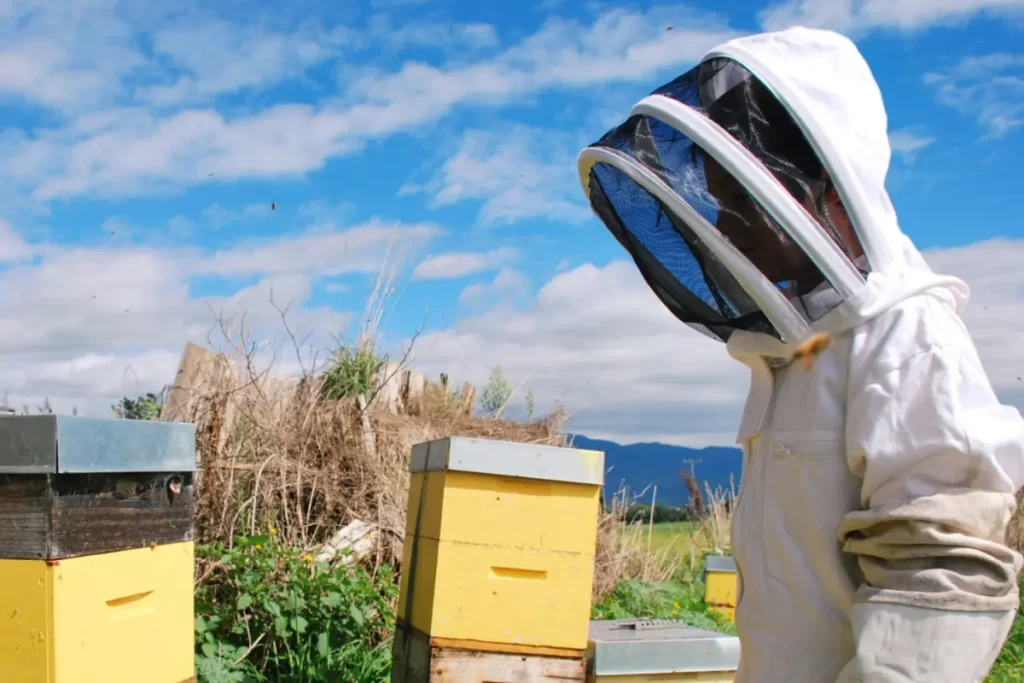
Bee suits protect you against bee stings, but they may not be as effective against wasps. They consist of a thick, tightly woven fabric that prevents bee stingers from penetrating the material. However, wasps have different stingers that are typically more slender and sharper than bees.
While a bee suit may offer some level of protection against wasp stings, it may not be as effective as it is against bee stings. Some wasps may still be able to sting through the fabric or find openings in the suit. Additionally, certain types of wasps can be more aggressive and persistent than bees, making them more likely to find a way to sting even if you are wearing a suit.
Therefore, if you are specifically dealing with wasps, it’s good to use specialized wasp protection gear, such as a wasp suit or jacket.
What Factors Influence Stinging Through Clothes?
Several factors can influence whether a wasp will sting through clothing or not. Here are some of the key factors that influence stinging through clothes:
- Fabric Thickness and Texture: Thicker fabrics like denim or canvas are less likely to be penetrated by a wasp’s stinger compared to thinner materials like cotton or linen. Additionally, rough textures may provide more protection than smooth ones.
- Tightness of Weave: Fabrics with a tight weave, like those found in denim or heavy canvas, are less likely to be pierced by a wasp’s stinger than loose weaves like those in lightweight cotton.
- Color: Wasps are generally attracted to bright and vibrant colors, so if you’re wearing something that catches their attention, they may be more likely to investigate and potentially sting.
- Movement and Vibration: Rapid or erratic movements can agitate wasps, making them more likely to sting. If you’re swatting at a wasp or making sudden movements, it may increase the likelihood of a sting.
- Provocation: If a wasp feels threatened or cornered, it’s more likely to sting as a defensive response. This can happen even if it doesn’t feel direct pressure on its body.
- Type of Wasp: Different species of wasps have varying temperaments. Some are more aggressive and prone to stinging, while others are more docile.
- Weather Conditions: Environmental factors like temperature and humidity can affect a wasp’s behavior. For example, they might be more irritable on hot, dry days.
- Your Scent: Some scents, such as perfumes or strong-smelling lotions, can attract wasps.
What Number of Layers of Clothing Can a Wasp Sting Through?
A wasp’s ability to sting through layers of clothing can vary depending on several factors, including the type of clothing, the thickness of the fabric, and the specific species of wasp. In general, a wasp’s sting is more likely to penetrate thin and lightweight clothing compared to thicker materials.
Most wasps have a stinger that punctures the skin of their prey or threats. Thicker clothing, such as denim or multiple layers, can provide some protection against a wasp’s sting, as it may have difficulty penetrating the fabric.
Therefore, if you are in an area with a high risk of wasp encounters, consider using insect repellent or other protective measures to reduce the chances of being stung.
Wasp Protective Clothing
Wasp-protective clothing is important for you if you work in professions or engage in activities that put you at risk of encountering wasps, such as beekeeping, pest control, or gardening. Here are some features and considerations for effective wasp-protective clothing:
- Full Coverage: The clothing should cover the entire body, leaving no exposed skin. Long sleeves, long pants, and closed-toe shoes are examples of this.
- Wear Fabric Tightly: The material should be tightly woven to prevent wasps from puncturing it with their stingers. Heavy-duty fabrics like canvas or denim can be effective.
- Light Colors: Light-colored clothing is generally recommended because wasps are less attracted to lighter colors. Avoid bright floral prints or dark colors which may attract them.
- Elastic Cuffs and Ankles: Elasticized cuffs at the wrists and ankles can help seal off potential entry points for wasps.
- Hood or Veil: A hood or a veil is crucial to protect the head and neck area. It should consist of fine mesh or netting that allows good visibility while preventing wasps from getting through.
- Zippered Closures: Clothing with zippered closures is preferable as it provides a secure seal, preventing wasps from finding their way inside.
- Gloves: Heavy-duty gloves, preferably with elasticized cuffs, are essential to protect the hands and wrists.
What Should You Wear while Removing a Wasp Nest?
Removing a wasp nest can harm you so, it’s important to take precautions to minimize the risk of their sting. Here are some recommendations for what to wear while removing a wasp nest:
Protective Clothing:
Long-Sleeved Shirt and Long Pants: Wear a long-sleeved shirt and long pants to cover as much of your skin as possible.
Thick Material: Choose clothing made of thick material to provide an extra layer of protection.
Tightly Woven Fabric: Make sure the fabric is tightly woven to prevent wasps from stinging through it.
Gloves:

Thick, Leather, or Rubber Gloves: Wear gloves that cover your hands entirely. Leather or rubber gloves can offer good protection against stings.
Footwear:
Closed-Toe Shoes or Boots: Wear closed-toe shoes or boots to protect your feet.
Head and Face Protection:
Face Shield or Goggles: Wear a face shield or goggles to protect your eyes from stings.
Respirator or Mask:
Respirator Mask: Consider wearing a respirator mask to protect yourself from inhaling any chemicals or irritants.
Use Appropriate Pest Control Products:
If you’re using chemicals or insecticides, follow the manufacturer’s instructions carefully and wear any recommended protective gear.
Wasps and Their Stinging Abilities
Different wasps have different stinging abilities. Below is the list of stinging abilities of some of the most common wasps:
Yellow Jacket Wasps
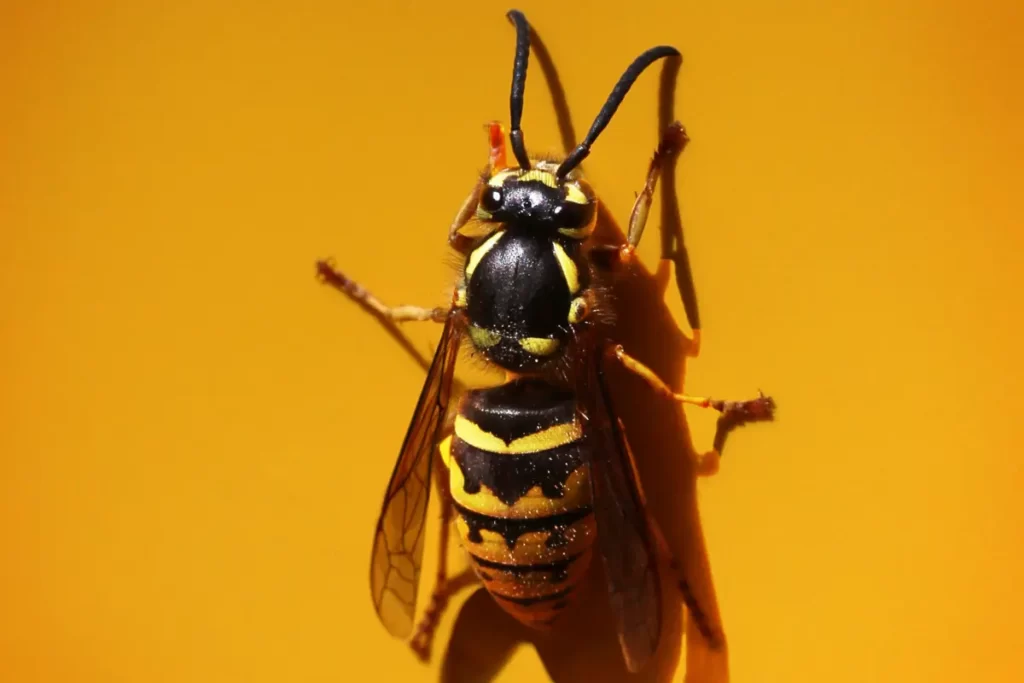
Yellow jacket wasps are prominent for their aggressive behavior and potent stinging ability. They are social wasps, which means they live in colonies with a queen, workers, and drones. When provoked or threatened, yellow jackets can deliver painful stings, and they are capable of stinging multiple times.
When a yellow jacket stings, it injects venom into your skin. The venom contains a mixture of chemicals, including proteins and peptides, which can cause pain, swelling, and in some cases, allergic reactions if you are sensitive or allergic to wasp venom.
Above all, it’s best to exercise caution and take preventive measures, such as avoiding known nesting areas and using appropriate insect repellents when spending time outdoors, especially during the warmer months when yellow jackets are most active.
Paper Wasps
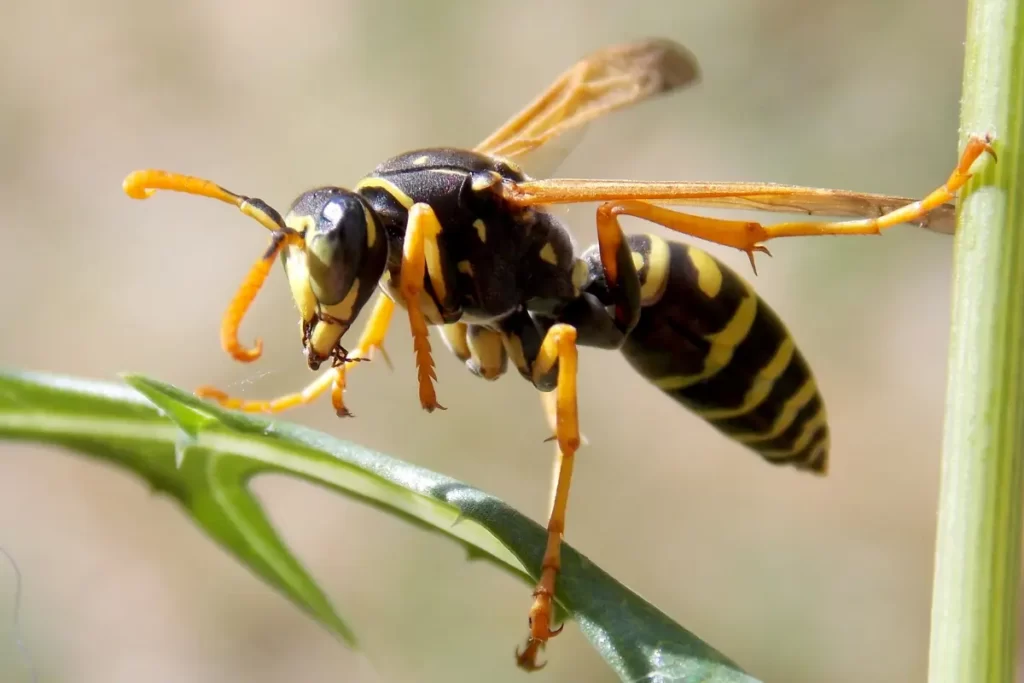
Paper wasps are popular for their potent stinging ability. They possess a stinger at the end of their abdomen, which is a modified ovipositor (the egg-laying organ in females). They use their stinger for defense, allowing them to protect themselves and their nests.
Paper wasps may sting numerous times without dying, in contrast to honeybees. It is because their stingers are not barbed, so they can withdraw them easily without causing harm to themselves.
The paper wasp’s sting contains a mixture of chemicals, including proteins and peptides, which can cause pain, redness, and swelling at the site of the sting. You may also experience allergic reactions to the venom, ranging from mild to severe.
Hornets
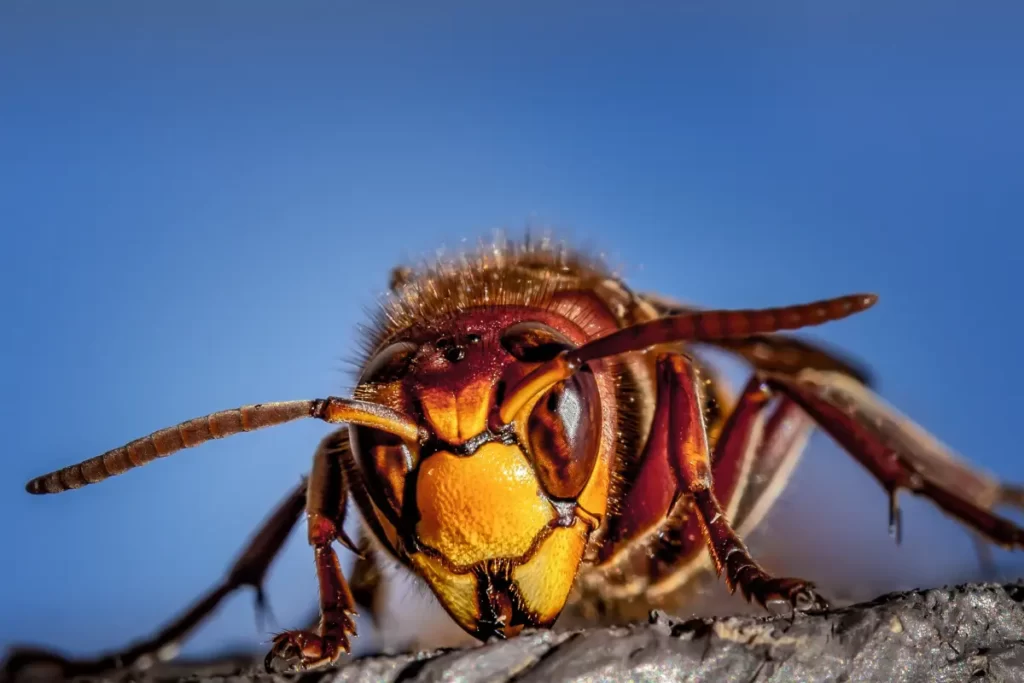
Hornets are famous for their potent stinging ability and they are among the largest and most aggressive members of the wasp family. The severity of their stings can vary depending on the hornet species and the individual’s sensitivity to the venom. Hornet stings are generally more painful than those of smaller wasps or bees.
Furthermore, hornets can sting multiple times without losing their stingers because their stingers are not like honeybees. They are highly protective of their nests and can become extremely aggressive when they perceive a threat. Disturbing a hornet nest can lead to a swarm of hornets attacking the intruder, resulting in multiple stings.
Cicada Killer Wasps
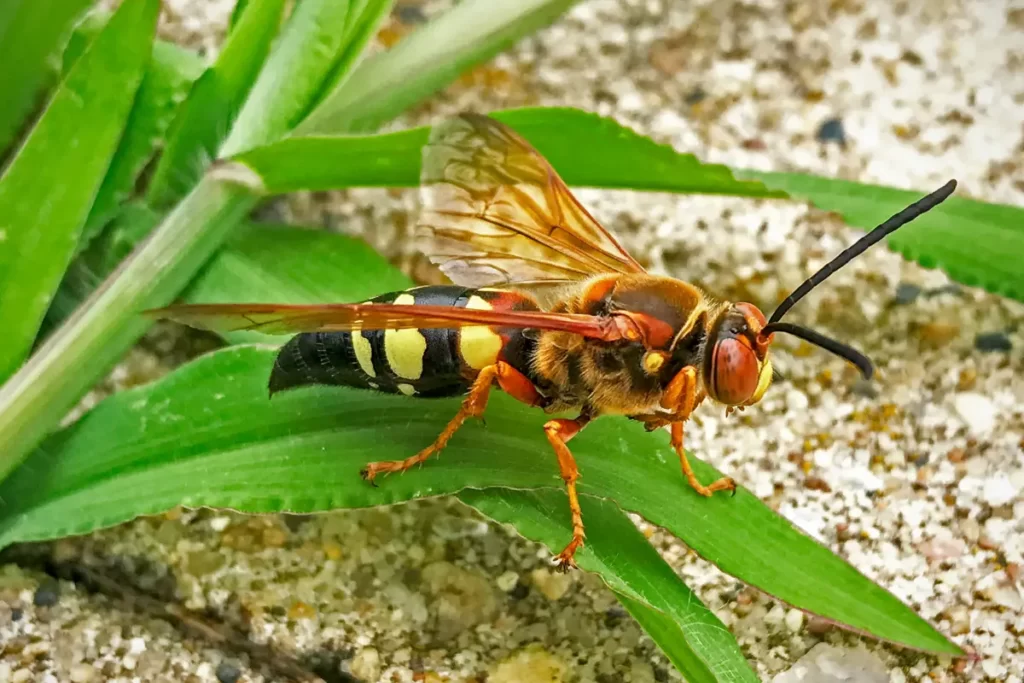
Cicada killer wasps are large, solitary wasps famous for their impressive size and hunting behavior. They are not like social wasps and defend their nests aggressively. Instead, cicada killer wasps are generally not aggressive toward humans and primarily hunt cicadas, which they use to feed their larvae.
The female wasp stings the cicada with its venomous stinger, injecting venom into the cicada’s body. The venom contains toxins that paralyze the cicada but don’t kill it. This paralysis ensures that the cicada remains alive but immobilized.
Except for people allergic to wasp stings, a cicada killer wasp’s sting can be painful but is not harmful to humans. In most cases, the pain and swelling from a cicada killer wasp sting will subside within a day or so.
Symptoms and Reactions of Wasp Sting
A wasp sting can cause a range of symptoms and reactions, which can vary depending on factors like the individual’s sensitivity to insect venom, the location of the sting, and the number of stings received. Here are common symptoms and reactions associated with a wasp sting:
- Immediate Pain or Burning Sensation: The initial sensation is usually a sharp pain or burning at the site of the sting.
- Redness and Swelling: The area around the sting may become red, swollen, and itchy.
- Itching: Itchiness is a common reaction to a wasp sting and can persist for several hours.
- Localized Reaction: You may experience a localized reaction, which means the symptoms are limited to the area around the sting.
- Systemic Allergic Reaction (Anaphylaxis): In some cases, you can have a severe allergic reaction to the venom, leading to anaphylaxis. Symptoms of anaphylaxis can include:
- Difficulty breathing or shortness of breath
- Rapid or weak pulse
- Nausea, vomiting, or diarrhea
- Dizziness or loss of consciousness
- Hives or Rash: You may develop hives (urticaria) or a generalized rash in addition to the localized reaction.
- Headache or Dizziness: In rare cases, you may experience a headache or dizziness after a wasp sting.
- Muscle Weakness or Tremors: Severe reactions can lead to muscle weakness or tremors.
- Nausea and Abdominal Pain: These symptoms may occur, particularly in cases of more severe reactions.
- Fever: In some cases, especially if multiple stings are involved, you may develop a mild fever.
Last but not least, if you or someone you know develops a severe reaction or anaphylactic symptoms following a wasp sting, get medical help right away.
Treatment of Wasp Sting
To reduce discomfort and the likelihood of an allergic reaction, it’s critical to treat a wasp sting very quickly. Here are the steps you should take:
- Remove the Stinger: Use a flat-edged object like a credit card or your fingernail to gently scrape across the skin. It helps to remove the stinger without squeezing more venom into the wound.
- Wipe the Area: Clean the affected area with soap and water to prevent infection.
- Apply a Cold Compress: Apply a cold pack or a clean cloth soaked in cold water to the sting site. It helps reduce swelling and pain.
- Use a Pain Reliever (if needed): Over-the-counter pain relievers like ibuprofen or acetaminophen can help alleviate pain and reduce inflammation.
- Apply a Topical Antihistamine or Hydrocortisone Cream: It can help relieve itching and inflammation. Follow the instructions on the product label.
- Elevate the Area: If the sting is on an arm or leg, try to keep it elevated to help reduce swelling.
- Avoid Scratching: Scratching the sting site can lead to further irritation and potential infection. Try to resist the urge to scratch.
- Keep an Eye on Symptoms: If you notice any signs of an allergic reaction, such as difficulty breathing, hives, rapid swelling, or dizziness, seek immediate medical attention. These can be signs of a severe allergic reaction that requires immediate medical attention.
- Seek Medical Attention: If you have a history of severe allergic reactions to insect stings, or if the symptoms worsen or persist for more than a few days, consult a healthcare professional.
How to Prevent Wasp Stings?
Preventing wasp stings involves a combination of awareness, protective measures, and sometimes professional assistance. Here are some steps you can take to minimize the risk of wasp stings:
- Avoid Wasp-Attracting Scents and Colors: Wasps are attracted to sweet scents, bright colors, and floral prints. Avoid wearing strong perfumes, scented lotions, or brightly colored clothing, especially when spending time outdoors.
- Keep Food and Drinks Covered: Use lids or covers for food and drink containers when dining outdoors. Wasps draw to sugary substances and may allure to open containers.
- Proper Garbage Disposal: Make sure trash cans have tightly sealed lids. Rinse out containers before placing them in the trash to remove any residual food or drink.
- Seal Entry Points: Inspect your home for gaps, cracks, or holes in walls, windows, and doors. Seal these entry points to prevent wasps from nesting indoors.
- Regular Inspection of Outdoor Spaces: Periodically check for wasp nests in and around your property. Early detection can help prevent large wasp infestations.
- Use Wasp Deterrents: Hang wasp deterrents in high-risk areas. These can be artificial wasp nests, which may deter other wasps from establishing nests in the same area.
- Protective Clothing: When spending time in areas where wasps are active, consider wearing long sleeves, long pants, closed-toe shoes, and a wide-brimmed hat. This provides an extra layer of protection.
- Be Cautious with Sweet Foods and Drinks: Be mindful when consuming sweet foods and beverages outdoors. Keep them covered and clean up spills promptly.
- Avoid Disturbing Nests: If you discover a wasp nest, do not attempt to remove it yourself. Contact a professional pest control service to remove wasps safely.
Conclusion
Wasps are one of the most threatening little insects. But you know, they may sting even if you wear clothes. Although wasps can sting through most clothes, thicker, densely woven textiles are better at shielding wearers from stings.
If a wasp stings you may experience symptoms, like pain, swelling, itching, etc. Therefore, if you accidentally encounter a wasp, it’s important to stay calm and quiet to protect yourself from its sting. When doing outdoor activities during wasp season, be cautious and adopt necessary safety measures.
Moreover, if you have a large wasp infestation or if you get severe allergic reactions after being bitten by a wasp, ask for help from professionals.
FAQs
Reference
Das, R., Yadav, R.N., Sihota, P. et al. Biomechanical Evaluation of Wasp and Honeybee Stingers. Sci Rep 8, 14945 (2018).
